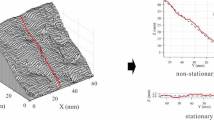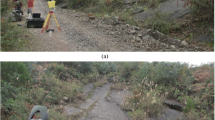Abstract
Rock joint roughness characterization is often an important aspect of rock engineering projects. Various methods have been developed to describe the topography of the joint surface, for example Joint Roughness Coefficient (JRC) correlation charts or disc-clinometer measurements. The goal of this research is to evaluate the accuracy, precision and limits of Terrestrial Laser Scanning (TLS) for making remote measurements of large-scale rock joints. In order to find the most appropriate roughness parameterization method for TLS data and to analyse the capability of TLS for roughness estimation, experiments were made with a 20 × 30 cm joint sample. The sample was scanned with TLS and compared to reference measurements made with the Advanced TOpometric Sensor (ATOS) system. Analysis of two roughness parameterization methods, virtual compass and disc-clinometer, and angular threshold method, showed that the latter is less sensitive to noise. Comparative studies of ATOS and TLS roughness parameters indicate that the TLS can adequately quantify surface irregularities with a wavelength greater than 5 mm from a distance of 10 m.
Access provided by Autonomous University of Puebla. Download conference paper PDF
Similar content being viewed by others
Keywords
1 Introduction
Rock joint roughness is an important factor influencing the potential for shear displacement to occur along an unfilled discontinuity at low normal stress (Patton 1966). Several methods have been developed to measure and parameterize roughness amplitude, anisotropy and scale effects, and to utilize these results in a joint shear strength failure criterion, e.g. (Patton 1966; Barton and Choubey 1977; Grasselli and Egger 2003). Prior research has typically considered small joint samples (<1 m2) measured in the laboratory environment. Comparatively few studies have investigated larger scale measurements of roughness in the field using shadow profilometry, total station, TLS, photogrammetry and ATOS. Among these, TLS enables fast, accurate and detailed acquisition of distant, inaccessible, large-scale surfaces. TLS data can be used for the extraction of first-order roughness (Sturzenegger and Stead 2009), which is defined by Priest (1993) as “surface irregularities with a wavelength greater than about 10 cm”, but the scale and range limitations of TLS measurements have yet to be investigated.
This contribution summarizes an experiment designed to investigate the intrinsic scale and range limitations of TLS. The influence of TLS data resolution and noise on roughness measurements is studied with ATOS data serving as a reference. Two different roughness parameterization methods are tested to evaluate parameter sensitivity to noise.
2 Quality of TLS Point Cloud and Roughness
The quality of a TLS point cloud, namely point accuracy and precision, and resolution, define to what detail roughness amplitude and wavelength (scale) can be observed.
The accuracy and precision of laser point position depends on instrumental errors of laser scanner, environmental conditions (e.g. lightness) and surface features (e.g. reflectivity). If noise is not separated and eliminated from the data, the joint roughness will be overestimated (Khoshelham et al. 2011). In this research, only noise related to the TLS range is considered. Besides, it is assumed that the noise is randomly distributed and that no systematic errors are present. With such assumptions, noise can be reduced by averaging redundant data points. Roughness parameter sensitivity to noise is studied using ATOS data, to which different levels of noise were added. Differences of roughness parameters computed from the noiseless and noise-induced ATOS data indicate the parameter noise sensitivity.
The resolution of TLS points is governed by nominal point spacing set at acquisition and actual footprint size, which depends on scanning geometry and laser beam width. The effective resolution defines the level of detail that can be resolved from a scanned point cloud. Decreasing resolution (i.e. increasing the sampling interval), results in smoothing of the discontinuity surface, indicating that data resolution defines roughness scale. Ignoring the variation of measurement resolution leads to misleading roughness estimation (Tatone and Grasselli 2012). Thus, when comparing joint roughness parameters using different measurement techniques, data should first be resampled to the same resolution.
3 Parameterization Methods
In this research, two roughness parameterization methods are applied. To facilitate roughness computations, the coordinate system of the data was aligned with the mean joint plane, with the x- and y-axis coinciding with joint dip and strike, respectively, and the z-axis with roughness amplitude.
The compass and disc-clinometer technique is a traditional, contact-based method of joint roughness measurement (Fecker and Rengers 1971). Discs of different sizes are placed on the joint surface. Dip and dip direction of the disc is measured, which correlate to roughness amplitude and direction, respectively. Roughness scale-dependency can be evaluated using discs of different sizes. The compass and disc-clinometer method is applied to digital data by using orthogonal least squares (OLS) linear regression. For the TLS data having embedded noise, a plane is fitted to all laser points lying within the area covered by a virtual disc. Data redundancy reduces the noise effect on plane calculation. For the reference ATOS data (which are assumed to be free of error) iterative plane fitting is performed.
The angular threshold concept was initially developed to identify potential contact areas during direct shear testing of artificial rock joints (Grasselli 2001). Based on joint surface damage patterns, it was found that only portions of the joint surface that face the shear direction and are steeper than a threshold inclination \( \uptheta^{*} \)provide shear resistance. A higher proportion of steeply inclined facets is indicative of a rougher surface, and is reflected by a larger area under the curve that expresses the potential contact area ratio as a function of \( \uptheta^{ *} \). The area under the curve is taken as the roughness parameter (henceforth referred to as the Grasselli parameter, R). The parameter R depends on shearing direction and the 3D surface representation, but does not consider the scale effect.
4 Experiments and Results
Data acquisition. A joint sample of fossil rich limestone was fixed on a wooden plate equipped with eight reference targets (Fig. 150.1a). The smaller circular ATOS targets with radius 7 mm were placed precisely at the center of 10 cm square TLS targets (Fig. 150.1b). The sample and targets were scanned with the Riegl VZ400 laser scanner (Riegl 2013), and imaged with the ATOS I measurement system (Capture3D 2013). Multiple TLS measurements were taken with different nominal resolution in the perpendicular direction and at a distance of 10 m.
Data preparation. The target centers were extracted from corresponding point clouds. The ATOS target centers were processed simultaneously with data acquisition in the ATOS I software. TLS target centers were computed using an image matching algorithm (Kregar et al. 2013). Using target coordinates the TLS and ATOS datasets are co-registered and transformed into a new coordinate system aligned with the joint plane. To eliminate TLS range noise and to enable roughness parameter comparison, both ATOS and TLS point clouds were interpolated into 1 and 5 mm grids. Each grid center was assigned the median height of the points within the grid cell. The triangulated 1 mm ATOS grid is shown in Fig. 150.1c.
4.1 Roughness Parameter Sensitivity to Noise
For the virtual disc-clinometer and Grasselli parameter algorithm, the dimension of the virtual disc and the grid size are chosen to be 5 mm, respectively. Reference ATOS parameters are then computed based on the described methodologies (Sect. 150.3). Five noise levels (1–5 mm) are added to the ATOS data and roughness parameters are recomputed. The median and 25th–75th percentiles of differences between reference and noisy parameters are shown in Fig. 150.2, where the dip differences are computed for the same disc positions (Fig. 150.2a) and Grasselli parameter differences for the same directions (Fig. 150.2b). Boxes 1–5 in Fig. 150.2 correspond to the five noise levels. Comparing the medians in Fig. 150.2, one can see that the dip is more sensitive to noise (i.e. has bigger median differences) than the Grasselli parameter. The reason might be that dip is computed directly from the data points and that orthogonal least squares results in artificially steep planes, when the noise level is close to disc size.
Reference ATOS dip measurements were also compared to results computed from original TLS data and 1 mm gridded TLS data (Fig. 150.2a, 6th and 7th box, respectively). Comparison of the 6th box to 7th shows that noise reduction by averaging the height within 1 mm grid cells was successful. The reference ATOS Grasselli parameters are compared to parameters computed from 5 mm grid TLS data (Fig. 150.2b, 6th box). Comparison of the 6th box to 1st indicates that TLS data resampled in 5 mm grid contain less than 1 mm noise.
4.2 Roughness Parameter Comparison
Based on results summarized in Sect. 150.4.1, TLS roughness parameters are compared to the reference ATOS parameters. A TLS grid of 1 mm and 5 mm are taken as input for the virtual disc-clinometer and Grasselli methods, respectively. Stereoplots in Fig. 150.3 show ATOS and TLS roughness parameters normalized to interval between zero (minimum) and one (maximum), which enables more detailed comparison. Direction 0° corresponds to y-axis (see Fig. 150.1c).
5 Conclusions
The use of TLS data for joint roughness computation has been investigated using two empirical roughness parameterization methods (virtual disc-clinometer method and Grasselli angular threshold method). Both methods are capable of representing roughness amplitude and its direction dependency. The sensitivity of roughness parameter measurements to TLS noise indicates that the Grasselli parameter is least sensitive. Dips of discs and the Grasselli parameters computed from gridded TLS data (reduced noise) were compared to the same parameters computed from reference ATOS measurements. Plot of maximum virtual disc dips in all dip directions show relatively poor correlation between ATOS and TLS results. Grasselli parameter plot show a significantly higher correlation between the data sets; however, the TLS surface roughness is systematically overestimated.
References
Barton N, Choubey V (1977) The shear strength of rock joints in theory and practice. Rock Mech Rock Eng 10(1):1–54
Capture3D (2013) Atos I, configurations. Accessed Oct 2013, from http://www.capture3d.com/products-ATOSI-configuration.html
Fecker E, Rengers N (1971) Measurement of large scale roughness of rock planes by means of profilograph and geological compass. In: Proceedings symposium on rock fracture, Nancy, France
Grasselli G (2001) Shear strength of rock joints based on quantified surface description. École Polytechnique Fédérale de Lausanne. Lausanne, EPFL
Grasselli G, Egger P (2003) Constitutive law for the shear strength of rock joints based on three-dimensional surface parameters. Int J Rock Mech Min Sci 40(1):25–40
Khoshelham K, Altundag D et al (2011) Influence of range measurement noise on roughness characterization of rock surfaces using terrestrial laser scanning. Int J Rock Mech Min Sci 48(8):1215–1223
Kregar K, Grigillo D, et al (2013) High precision target center determination from a point cloud. ISPRS workshop laser scanning 2013. Antalya, Turkey. ISPRS Annals of the Photogrammetry, Remote Sensing and Spatial Information Sciences, vol II-5/W2
Patton FD (1966) Multiple modes of shear failure in rock. 1st ISRM Congress. Lisbon, Portugal, International Society for Rock Mechanics, pp 509–513
Riegl (2013) Laser Scanner VZ-400, Datasheet. Accessed Oct 2013, from http://www.riegl.com/nc/products/terrestrial-scanning/produktdetail/product/scanner/5/
Sturzenegger M, Stead D (2009) Close-range terrestrial digital photogrammetry and terrestrial laser scanning for discontinuity characterization on rock cuts. Eng Geol 106(3–4):163–182
Tatone B, Grasselli G (2012) An investigation of discontinuity roughness scale dependency using high-resolution surface measurements. Rock Mech Rock Eng 1–25
Acknowledgements
The Slovenian National Building and Civil Engineering Institute kindly provided access to their ATOS measuring system and assisted in data acquisition.
Author information
Authors and Affiliations
Corresponding author
Editor information
Editors and Affiliations
Rights and permissions
Copyright information
© 2015 Springer International Publishing Switzerland
About this paper
Cite this paper
Bitenc, M., Kieffer, D.S., Khoshelham, K., Vezočnik, R. (2015). Quantification of Rock Joint Roughness Using Terrestrial Laser Scanning. In: Lollino, G., et al. Engineering Geology for Society and Territory - Volume 6. Springer, Cham. https://doi.org/10.1007/978-3-319-09060-3_150
Download citation
DOI: https://doi.org/10.1007/978-3-319-09060-3_150
Published:
Publisher Name: Springer, Cham
Print ISBN: 978-3-319-09059-7
Online ISBN: 978-3-319-09060-3
eBook Packages: Earth and Environmental ScienceEarth and Environmental Science (R0)







